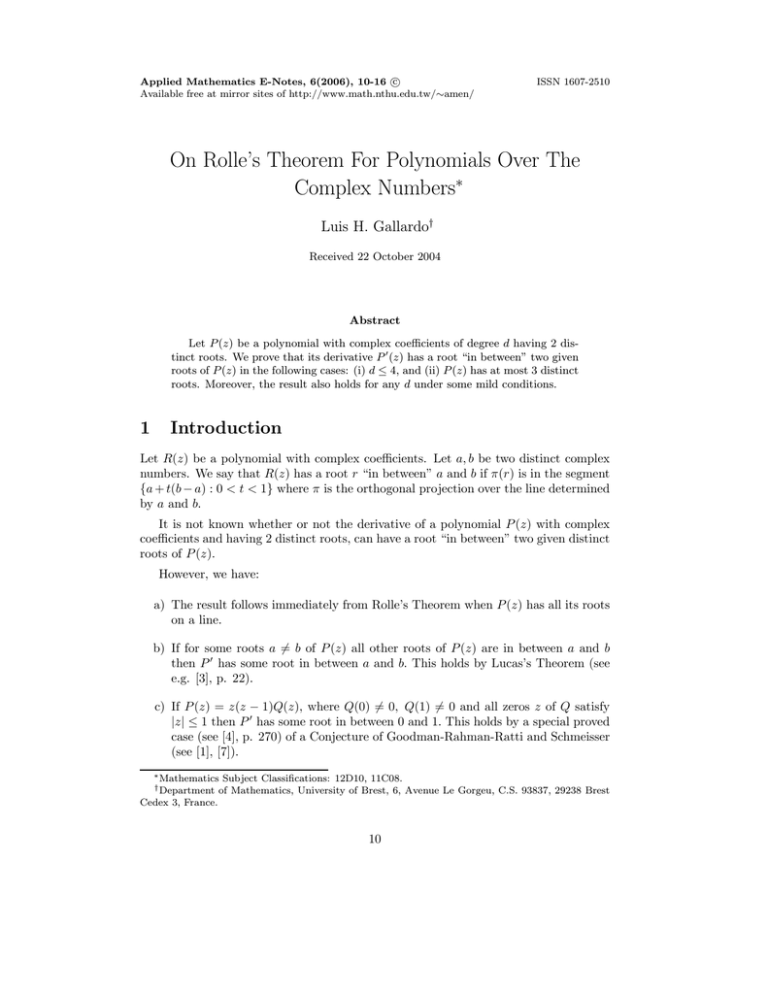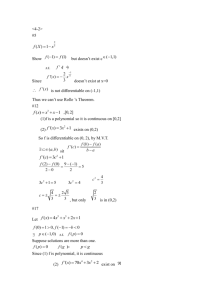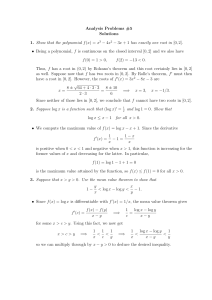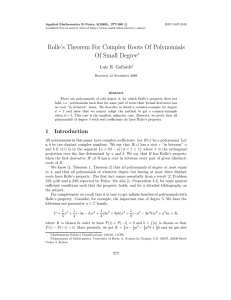Document 10677264
advertisement

Applied Mathematics E-Notes, 6(2006), 10-16 c
Available free at mirror sites of http://www.math.nthu.edu.tw/∼amen/
ISSN 1607-2510
On Rolle’s Theorem For Polynomials Over The
Complex Numbers∗
Luis H. Gallardo†
Received 22 October 2004
Abstract
Let P (z) be a polynomial with complex coefficients of degree d having 2 distinct roots. We prove that its derivative P (z) has a root “in between” two given
roots of P (z) in the following cases: (i) d ≤ 4, and (ii) P (z) has at most 3 distinct
roots. Moreover, the result also holds for any d under some mild conditions.
1
Introduction
Let R(z) be a polynomial with complex coefficients. Let a, b be two distinct complex
numbers. We say that R(z) has a root r “in between” a and b if π(r) is in the segment
{a + t(b − a) : 0 < t < 1} where π is the orthogonal projection over the line determined
by a and b.
It is not known whether or not the derivative of a polynomial P (z) with complex
coefficients and having 2 distinct roots, can have a root “in between” two given distinct
roots of P (z).
However, we have:
a) The result follows immediately from Rolle’s Theorem when P (z) has all its roots
on a line.
b) If for some roots a = b of P (z) all other roots of P (z) are in between a and b
then P has some root in between a and b. This holds by Lucas’s Theorem (see
e.g. [3], p. 22).
c) If P (z) = z(z − 1)Q(z), where Q(0) = 0, Q(1) = 0 and all zeros z of Q satisfy
|z| ≤ 1 then P has some root in between 0 and 1. This holds by a special proved
case (see [4], p. 270) of a Conjecture of Goodman-Rahman-Ratti and Schmeisser
(see [1], [7]).
∗ Mathematics
† Department
Subject Classifications: 12D10, 11C08.
of Mathematics, University of Brest, 6, Avenue Le Gorgeu, C.S. 93837, 29238 Brest
Cedex 3, France.
10
L. Gallardo
11
See also the comprehensive papers of Marden ([2], [3], [4], and [5]).
We let n(z) = |z|2 = zz̄, denote the square of the norm, T r(z) = z + z̄ denote the
trace of a complex z, and Re(z) = T r(z)/2 denote the real part of z.
Observe that we may assume that P (z) has the form:
P (z) = (z 2 − 1/4) R(z)
in which R(z) is some monic polynomial. Thus we will search for roots of the derivative
P in the region
S = {z ∈ C | −1/2 < Re(z) < 1/2}.
2
Some Results For General d
They are presented in the following Proposition:
PROPOSITION 1. Let n be a positive integer. Assume that d = n + 1 so that
deg(R(z)) = n − 1. Write R(z) = z + Q(z) where Q (0) = 0; i.e., is the coefficient of
z in R(z). Thus, P (z) = (z 2 − 1/4)( z + Q(z)). It is convenient to write P (z) as:
P (z) = (n + 1)(z − z1 ) . . . (z − zn ),
P (z) = (n + 1)
n
[
(−1)n−k sn−k z k .
k=0
(a) If
= 0 then z = 0 is a root of P .
(b) If | | < (n + 1)/2n−2 then for some integer i we have |T r(zi )| < 1.
n
(c) If there is a k such that |sk /sn | >
2n−k then for some i we have |T r(zi )| <
k
1.
(d) If P has only one root a then T r(a) = 0.
PROOF. We obtain (a) since z divides Q (z) when = 0. Observe that P (0) =
− /4. Thus | | = 4(n + 1)|z1 | . . . |zn |. Assume that |T r(zi )| ≥ 1 holds for all i. From
the inequality |zi | ≥ 1/2|T r(zi )| we obtain
| | ≥ (n + 1)/2n−2 .
This proves (b). The proof of (c) is similar. To prove (d) assume that P = (n +
1)(z − a)n for some complex a. It follows that P (z) = (z − a)n+1 + b for some complex
constant b. Since 1/2 and −1/2 are roots of P (z) we obtain
(1/2 − a)n+1 = (−1/2 − a)n+1 .
12
Rolle’s Theorem For Complex Polynomials
Thus a ∈
/ {1/2, −1/2} and
1/2 − a = ρ(−1/2 − a)
(1)
for some complex ρ = 1 that satisfy ρn+1 = 1. It follows that n(ρ) = 1 and that
T r(ρ) = 2. In other words (1) may be written as
a = (−1/2)
ρ+1
.
ρ−1
(2)
From (2) we obtain
T r(a) = (−1/2)
ρ̄ − ρ + ρ − ρ̄
= 0.
2 − T r(ρ)
This completes the proof of the proposition.
3
Case When P Has At Most 3 Different Roots
First of all we recall that an involution f is an operator of period 2, i.e. f ◦ f gives the
identity. Assume that for some positive integers α, β; for some non negative integer γ,
and for some complex number a ∈
/ {−1/2, 1/2}
P (z) = (z − 1/2)α (z + 1/2)β (z − a)γ .
The solution of our problem shall be reduced to prove that some involution h of
the Riemann sphere attached to these numbers transforms complex numbers z, with
|T r(z)| ≥ 1, into complex numbers w = h(z) with |T r(w)| < 1 :
LEMMA 1. Given positive integers α, β, γ let h be the involution of the Riemann
sphere S2 defined over a complex z by:
w = h(z) =
Az + B
,
Cz + D
(3)
where
(a) A = 2(−α2 + β 2 − (α − β)γ),
(b) B = −((α − β)2 + (α + β)γ),
(c) C = 4((α + β)2 + (α + β)γ),
(d) D = −A = 2(α2 − β 2 + (α − β)γ).
Then |T r(z)| ≥ 1 implies |T r(w)| < 1.
PROOF. After some computation it becomes clear that T r(w) < 1 is equivalent to
the condition
C1 > 0
L. Gallardo
13
where
C1 = 8αs((β − α)(β − α − γ) − 2(β 2 − α2 − αγ)t + 4(α + β)sn)
(4)
and
s = α + β + γ, t = T r(z), n = n(z).
One has the inequality
4n ≥ t2 .
Thus, it suffices to prove that
K1 = 8αs((β − α)(β − α − γ) − 2(β 2 − α2 − αγ)t + (α + β)st2 ) > 0;
i.e., it suffices to prove that K > 0 where
K = K1 /(8α(α + β)s2 ).
In other words, we need to prove that
K = (t − t1 )(t − t2 ) > 0,
where
t1 =
β−α
β−α−γ
, t2 =
.
β+α
β+α+γ
But, this holds since |t| ≥ 1 while trivially −1 < t1 , t2 < 1.
Similarly, we may prove that T r(w) > −1 since it shall suffice to prove that
C2 = 8βsL > 0,
where
L = (β − α)(β + γ − α) − 2(γβ + β 2 − α2 )t + 4(α + β)sn.
This completes the proof of the lemma.
We are ready to present our main theorem.
THEOREM 1. Let a be a complex number, let α, β be positive integers and let γ
be a non negative integer. Let P (z) be a polynomial defined by
P (z) = (z − 1/2)α (z + 1/2)β (z − a)γ .
Then P has a root r that satisfy
|T r(r)| < 1.
PROOF. When a ∈ {−1/2, 1/2} we may assume that γ = 0. From the equation
P (z)/P (z) = α/(z − 1/2) + β/(z + 1/2) = 0,
14
Rolle’s Theorem For Complex Polynomials
we obtain
z=
β−α
.
2(β + α)
From this it follows readily that
|T r(z)| < 1,
completing the proof in this case.
The equation
P (z)/P (z) = α/(z − 1/2) + β/(z + 1/2) + γ/(z − a) = 0,
may be written in the form
(z − z1 )(z − z2 ) = 0,
where
(a) z1 + z2 =
(b) z1 z2 =
(1/2+a)β−(1/2−a)α
,
α+β+γ
a(β−α)/2−γ/4
.
α+β+γ
From these 2 equalities, we obtain after some computation
z2 = h(z1 )
where h is defined in Lemma 1. The result follows immediately from the same lemma.
See ([4], p. 268) and ([3], p. 9) for a geometric interpretation of the position in the
complex plane of the zeros z1 , z2 above.
4
Case Of deg(P ) ≤ 4
The resolution of this case comes essentially from a result of Grace and Heawood
reported by Polya:
LEMMA 2. Let a = b be two distinct complex numbers. Let d be a positive integer.
Let P (z) be a polynomial of degree d with complex coefficients such that
P (a) = 0 = P (b). Then P has a root r that satisfies
|r − (a + b)/2| ≤ |(a − b)| / (2 tan(π/d)).
PROOF. See [6] Problem 150, p. 60 and p. 238.
REMARK. Observe that Proposition 1 part (b) and also Lemma 2 imply Rolle’s
Theorem for
deg(P ) ≤ 3.
L. Gallardo
15
Indeed, it remains only some polynomials to study:
LEMMA 3. Let P (z) be a polynomial of degree d ≤ 4 with complex coefficients
such that P (1/2) = 0 = P (−1/2) and such that gcd(P , z 2 − 1/4) = 1 then P has a
root r that satisfy
|T r(r)| < 1.
PROOF. Following the Remark we may assume that n = 4. Observe that if the
result holds for P (z) then it also holds for −P (−z). So, it suffices to study the following
polynomials:
(a) ((z 2 − 1/4)2 ) = (2z − 1)(2z + 1)z,
(b) ((z 2 − 1/4)(z − 1/2)2 ) = (1/4)(4z + 1)(2z − 1)2 ,
/ {−1/2, 1/2}.
(c) P (z) = (z 2 − 1/4)(z − 1/2)(z − a) where a ∈
The cases (a) and (b) are also easily deduced from Proposition 1 part (b). Observe
that P (z) has 3 distinct roots in the case (c) above. Thus the result follows from
Theorem 1.
We are ready to present the main result of the section:
THEOREM 2. Let P (z) be a polynomial of degree d ≤ 4 with complex coefficients
such that P (1/2) = 0 = P (−1/2) then P has a root r that satisfy
|T r(r)| < 1.
PROOF. The result follows immediately from Lemmata 2 and 3.
When P (z) has 4 distinct roots, and d ≥ 5, the problem seems non trivial.
Acknowledgments. I discovered the problem in an old version of the Web page of
Denis Simon. We thank the Mathematics Department of the Penn State University at
University Park campus, for hospitality. This helped us to complete this paper while
working with Leon Vaserstein in our main subject (Waring’s problem for polynomials).
Thanks also to the referee that improved our former proof of Lemma 3 by suggesting
the Remark.
References
[1] A. W. Goodman, Q. I. Rahman and J. S. Ratti, On the zeros of a polynomial and
its derivative, Proc. Amer. Math. Soc., 21(1969), 273—274.
[2] M. Marden, The location of the zeros of the derivative of a polynomial, Amer.
Math. Monthly, 42(5)(1935), 277—286.
[3] M. Marden, Geometry of Polynomials, Math. Surveys no. 3, American Mathematical Society, 1966.
16
Rolle’s Theorem For Complex Polynomials
[4] M. Marden, Conjectures on the critical points of a polynomial, Amer. Math.
Monthly, 90(4)(1983), 267—276.
[5] M. Marden, The search for a Rolle’s Theorem in the complex domain, Amer. Math.
Monthly, 92(9)(1985), 643—650.
[6] G. Pólya and G. Szegö, Problems and Theorems in Analysis, Volume II, SpringerVerlag, 1976.
[7] G. Schmeisser, Bemerkungen zu einer Vermutung von Ilieff, Math. Z., 111(1969),
121—25.








